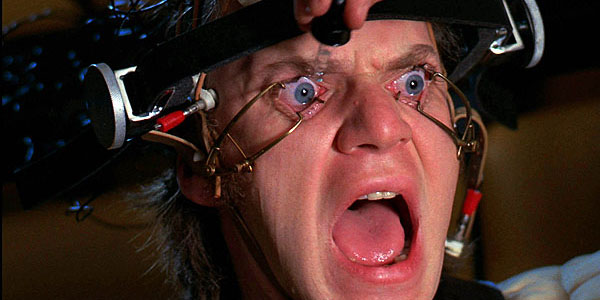4. A Clockwork Orange (1971)

Is it possible for there to be a utopian future without violence? Its unimaginable to talk about experiments gone wrong without dropping Stanley Kubricks masterpiece into the mix. To be honest, its fun to drop A Clockwork Orange into anything. But this film is much more than a sci-fi disaster as the experiment used raises key questions on if morality can be maintained when there is no choice. What we witness is an example of aversion therapy, a form of brainwashing, through the Ludovico technique. Subject: Alex (Malcolm McDowell). A murderer currently two years into his fourteen year prison sentence with an addiction to violence. Experiment: Have said volunteers eyes glued open as he watches a series of violent images whilst drugged on a nausea-inducer. Outcome: This experiment will make Alex feel sick whenever he is in a dangerous situation so he is unable to participate in violence. Effect: Alex is unable to defend himself when he is repeatedly attacked and he suffers the worst pain of any music lover: unable to listen to his favourite track, in this case, Beethoven's Ninth Symphony. Verdict: Controlling violence is possible, but it imposes dire consequences on its subject.
 Is it possible for there to be a utopian future without violence? Its unimaginable to talk about experiments gone wrong without dropping Stanley Kubricks masterpiece into the mix. To be honest, its fun to drop A Clockwork Orange into anything. But this film is much more than a sci-fi disaster as the experiment used raises key questions on if morality can be maintained when there is no choice. What we witness is an example of aversion therapy, a form of brainwashing, through the Ludovico technique. Subject: Alex (Malcolm McDowell). A murderer currently two years into his fourteen year prison sentence with an addiction to violence. Experiment: Have said volunteers eyes glued open as he watches a series of violent images whilst drugged on a nausea-inducer. Outcome: This experiment will make Alex feel sick whenever he is in a dangerous situation so he is unable to participate in violence. Effect: Alex is unable to defend himself when he is repeatedly attacked and he suffers the worst pain of any music lover: unable to listen to his favourite track, in this case, Beethoven's Ninth Symphony. Verdict: Controlling violence is possible, but it imposes dire consequences on its subject.
Is it possible for there to be a utopian future without violence? Its unimaginable to talk about experiments gone wrong without dropping Stanley Kubricks masterpiece into the mix. To be honest, its fun to drop A Clockwork Orange into anything. But this film is much more than a sci-fi disaster as the experiment used raises key questions on if morality can be maintained when there is no choice. What we witness is an example of aversion therapy, a form of brainwashing, through the Ludovico technique. Subject: Alex (Malcolm McDowell). A murderer currently two years into his fourteen year prison sentence with an addiction to violence. Experiment: Have said volunteers eyes glued open as he watches a series of violent images whilst drugged on a nausea-inducer. Outcome: This experiment will make Alex feel sick whenever he is in a dangerous situation so he is unable to participate in violence. Effect: Alex is unable to defend himself when he is repeatedly attacked and he suffers the worst pain of any music lover: unable to listen to his favourite track, in this case, Beethoven's Ninth Symphony. Verdict: Controlling violence is possible, but it imposes dire consequences on its subject.